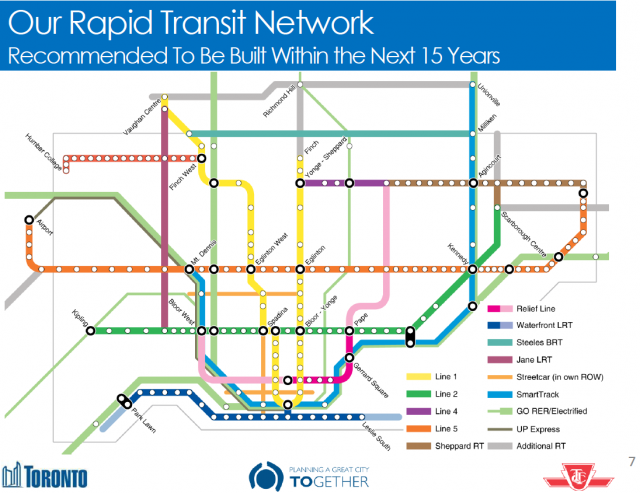During the Relief Line public meetings I made it a point to prod and ask staff the right questions about Metrolinx's commitment to the RL, and the Prov's willingness to work alongside the City/TTC. The answer I was given (or at least I interpreted) is that Metrolinx seldom meets with the TTC/City, does so only briefly, and doesn't like sharing info.
Same ol, same ol. I'm for the extension, you're against it (at least in its proposed form) and round and round it goes.
The way I see it is that Metrolinx and York Region are on one side (the side pushing for extending TO's subway into York Region ASAP + offering the bare minimum in quick-fix relief), whereas the City of Toronto is naturally on the logical side of finally building a proper DRL.
This is pure spin. Metrolinx's "side" is to look at the big picture of regional planning. That's not the TTC's job and it's a good thing because they are piss poor at it. Metrolinx isn't infallible and they need to be restructured, IMHO, but it's still their job.
It's a real stretch to say Toronto is 'naturally on the logical side' of pushing for the DRL. That wasn't true under David Miller and it wasn't true under Rob Ford either and it's hard to argue - despite Keesmaat et al pushing forward with it - that it's true under Tory either. It ONLY became an issue when the yonge extension ended up on their plate and, yes, it was Metrolinx (then joined by YR) who put it there.
Metrolinx has no real power over TTC and what you describe in terms of them not interacting isn't just a TTC-Metrolinx problem; it's a multi-issue, multi-municipality problem. Fact is, TORONTO prioritized Transit City and so Metrolinx put the DRL on their long-term list. When TORONTO asked them to move it up to the 15-year list, they did. If TORONTO had chosen to prioritize it over Scarborough over SmartTrack and Metrolinx didn't agree, then you could harp on this but that's the opposite of what's happened so even if it's true Metrolinx is "disinterested" in the DRL, there's no blame to be directed their way yet. All the rest of your talk is just revisionist history, as if TO has been promoting DRL forever to deaf ears. Not the case at all. And I say that as someone who has long said they should have built the DRL years ago, but they CHOOSE not to, and now RER and SmartTrack are altering its significance.
(I think it's actually laughable how TO planning is working on the DRL and Ford's subway is moving along and now SmartTrack and there has been almost no work to actually figure out how they interface or what the cumulative impact is. I, for one am thankful Metrolinx is actually doing this kind of work.)
It's almost as if those pushing hard for Yonge North are still living in the previous decade of ample funds and fanciful/questionable plans, and haven't yet acknowledged the extremely high cost of their project, or the effect of extending a city's subway line (that reached capacity 30yrs ago).
And it's almost as if those against it are ignoring the Hydro sale and the funds specifically earmarked for transit coming out of it. You're exaggerating the cost and the "effect."
Re: RER on the RH line. It's been both common knowledge and a unanimous agreement for years that the existing RH GO route is of little use and would have low ridership.
Really? And yet how many times have I seen, on this very forum, person after person saying that Richmond Hill doesn't NEED a subway; that adding RER there will serve all their needs just fine?
The Yonge North study concluded this years ago, so it shouldn't be a 'significant claim' that the recent YRNS report concluded the same thing. One, with the current routing there'd be nothing "express" about it...it's a slow and circuitous route. Two, there's no opportunity for stations between Oriole (Sheppard) and Union. Three, electrified RER wouldn't be built in a flood-prone floodplain. All in all, the current alignment would never work as RER. So obviously it wouldn't attract "subway-needing riders" - whether they're from TO or Thornhill.
I totally agree! but even if it's a rare point of agreement for you and I (and pretty obvious, just looking at a map) it's one of the arguments brought to bear against the extension by others.
your realingment proposal strikes me as dubious but, quite honestly, I have no clue how viable it is. I can only infer based on how little people at Metrolinx and elsewhere have looked at it how unviable it must be. Occam's Razor prevents me from agreeing with your suggestion that it's being ignored as part of a pro-Yonge-North conspiracy, however.
Anyway, overall, the report's conclusions make sense to me: RER eliminates the immediate need for DRL and removes that singular obstacle to the Yonge extension. But that's not to say that a DRL (even a more ambitious route than Toronto has been looking at) is needed not long after. The question has never really been whether it's needed but whether it's a pre-requisite for the extension and that's how RER has changed the "game," which is a figure of speech, by the way.
